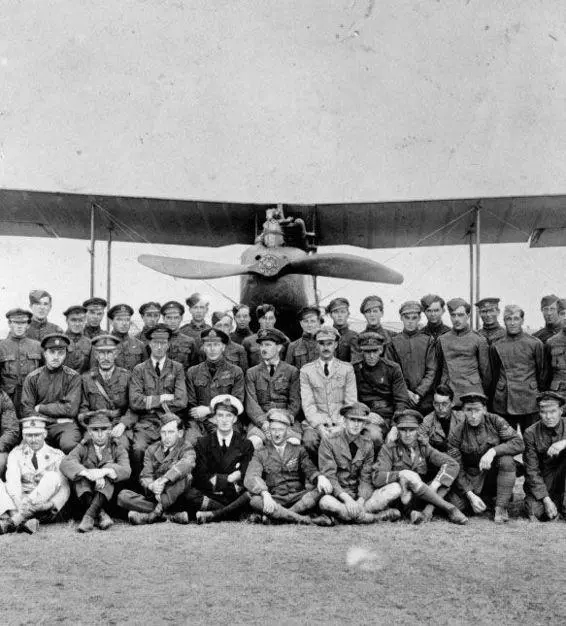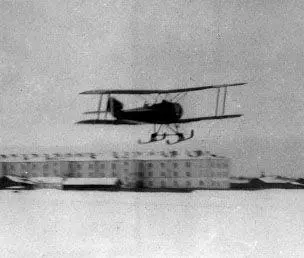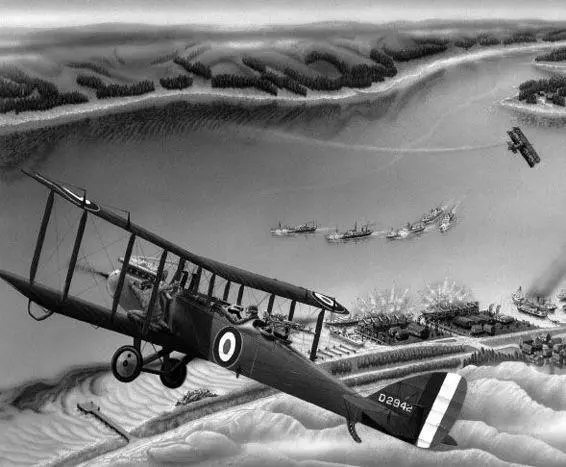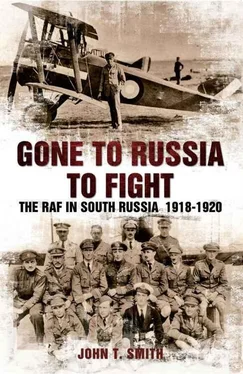John T. Smith
GONE TO RUSSIA TO FIGHT
THE RAF IN SOUTH RUSSIA 1918–1920

By the same author:
Rolling Thunder
The Linebacker Raids

Detail of picture here.
Map One: The area of operations for Dunsterforce
Map Two: The area around Tsaritsin
Map Three: The area of operations for 47 Squadron
Map Four: Fort Alexandrovsk harbour

Most of the information about the RAF in south Russia is contained in the National Archives at Kew. The staff at Kew are never less than helpful and courteous. The people at the RAF Museum, Hendon, London are real enthusiasts and I thank them for the help they gave me. Other sources consulted were:
The Tank Museum at Bovington, Dorset
The Army Museum at Chelsea, London
The British Library, London
The Maritime Museum at Greenwich, London
The Canadian National Archives
The Canadian Armed Forces Museum
The US National Archives
The photographs are from the Canadian Archives and the Canadian Armed Forces Museum. I would like to thank David Rogers, who read the manuscript. Any mistakes are all mine.
The quality of some of the photographs is poor but they have been included because they were the best available.

A painting by Mick Davison depicting the incident on 30 July 1919 over the Volga River port of Tcherni-Yar, for which Captain W. F. Anderson and Lieutenant Mitchell were both awarded the DSO. Captain Anderson was the pilot of a DH9 that was hit by ground fire in the fuel tank, and Lieutenant Mitchell was forced to climb out onto the wing to block the leaking fuel with his thumb. Another DH9 in Anderson’s flight was also hit by machine gun fire and forced to land behind enemy lines. Anderson landed close by and picked up Captain Elliot and Lieutenant Laidlaw. With Mitchell still on the wing, Anderson managed to take off, just before an enemy cavalry patrol arrived, and fly them back to base.
Very little has been written about the RAF in south Russia and much of what has been written has been inaccurate. Several myths have been accepted as truths and written into the histories. This book is an attempt to set the record straight by going back, where possible, to the primary sources.
The first wave of RAF personnel sent to south Russia was not given any choice in the matter. Most of the men had volunteered or been conscripted to fight in the First World War against Germany, Austria, and Turkey. They found themselves, after the end of the ‘real’ war, fighting in the middle of Russia in a civil war they knew little of and cared even less about. But they overcame enormous difficulties and made a substantial contribution to General Denikin’s temporary successes.
The second wave of RAF people sent to south Russia comprised volunteers. These included many experienced flyers from the Western Front in France and from the Middle East. Many of them had found great difficulty in settling down to peace and relished the chance of further combat in Russia. Together with those people from the first wave who decided to stay, these later volunteers formed an elite group who played a leading part in the civil war, out of all proportion to their limited numbers. The exploits, in difficult circumstances, of the RAF in south Russia deserve to be better remembered.
The RAF men seem to have liked and respected the Russians individually, but did not understand the Russian way of doing things. The massive corruption in Denikin’s Army, whereby large amounts of money and equipment simply vanished, forced the British to lose faith in the eventual victory of the White Armies.
With the success of the Red Army and the creation of the Soviet Union, there seems to have been a conscious effort by the British authorities to play down or forget the part that Britain played in the efforts to crush the nascent communist state. But the RAF achieved amazing things and deserve to have the truth told about their deeds in south Russia.
In late 1919, the RAF changed from Army ranks to RAF ranks. Army ranks have been used throughout this book to avoid confusion.
CHAPTER ONE
THE RUSSIAN CIVIL WAR
The Russian Civil War was one of the major wars of the twentieth century. It lasted between 1917 and 1926, but the main fighting took place between 1918 and 1920. Thirteen million Russians died during the course of the war. Most of these died of starvation, privation, and pestilence rather than as a result of direct military action. As in all civil wars, there were acts of extreme atrocity on both sides. In fact, it is hard to speak of two sides, as what are called the White Armies were never united in any common cause and covered all factions of political thought and ethnic backgrounds. Some sections of the anti-Bolshevik forces spent more time fighting each other than the Red Army. Also involved were the troops of up to fourteen foreign countries, including Britain, France, Japan, America, Greece, and Rumania. At the time of the Civil War, Russia was the largest country in the world and the fighting extended from the Arctic in the north to the deserts in the south and from Poland in the west to Vladivostok in the east.
The massive destruction caused by the First World War had triggered unrest among the revolutionary forces that had existed in Russian society for many years. In February 1917, the first Revolution deposed the Tsar and created the Kerensky government. But the decision to stay in the war allowed the more extreme revolutionary forces to continue to press for a more radical government. What was left of the Imperial Army began to fade away from the front line as a consequence of both these revolutionary pressures and military exhaustion. The October Revolution (November in the new calendar) created what became the Soviet government. This new government found itself beset by opponents on all sides.
As the Bolsheviks had played a large part in destroying the Imperial Army, they found themselves with few forces to fight the gathering enemies they faced. Trotsky is usually credited with creating the Red Army, and there is no doubt that he played a considerable role. Rather than use what remained of the Tsar’s Army, the first reaction was to build a new Army based on the Red Guards. These were originally armed factory workers, who elected their commanders and discussed every action before carrying it out. As the new state came under threat, large numbers volunteered to join the new Army and, later still, millions were conscripted. When revolutionary fervour was found to be no substitute for military experience, Trotsky was forced to employ thousands of ex-Tsarist officers as ‘military specialists’. But he placed a party commissar alongside each officer. As the fighting continued, the Red Army slowly became a conventional Army, with no pretence of electing officers or discussions of any decisions. Party orders were enforced with an iron hand, and thousands of Red Army soldiers were killed to enforce discipline.
Читать дальше

















